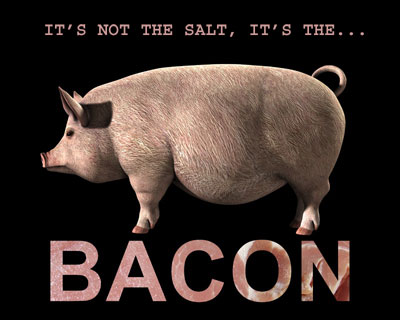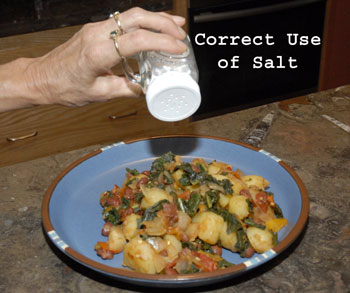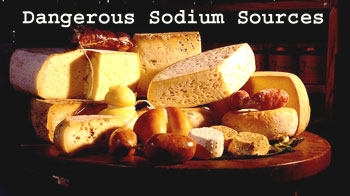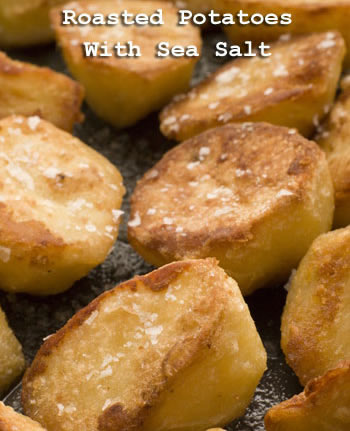Salt: The Scapegoat for the Western Diet
|
During my seven years of medical school and residency training, which began forty years ago, I learned two—only two—dietary lessons to share with my patients: switch from butter to margarine and reduce salt. Both pearls were supposed to save my patients from heart attacks and strokes, but neither did. The trans fats in margarine actually promote artery disease. Their dangers are so well recognized that the state of California, New York City, Philadelphia, Boston, Brookline, and Montgomery County, MD have banned the use of these synthetic fats in restaurants. Remaining is only one pillar of knowledge from my basic education, "Don't eat salt."

Sodium restriction is today the most widely publicized non-medication recommendation for heart disease and stroke prevention. Unfortunately, this advice has proven ineffective. Despite the vast amount of scientific research that has been published over the past seventy years, there is still little agreement as to the efficacy, safety, and acceptability of dietary salt reduction.1 In 2007, the authors of the Third National Health and Nutrition Examination Survey (The NHANES III study) representing nearly 100 million US adults reported that there is “ a robust, significant, and consistent significant inverse association between dietary sodium and cardiovascular mortality.”2 This means people who eat more salt have a lower risk of death from heart disease and stroke.
Even if less salt meant better health, people’s eating habits are near impossible to change, simply because so few of us are able to successfully make the transition to what are considered to be unpalatable foods. Our biological craving for salt has made this an unachievable goal. Focusing on an impossible dream—“eat low salt”—does, however, assure no consequential health changes will occur in our society—and that means consumers continue their same buying habits, food companies remain highly profitable, people remain sick, and drug companies enjoy record profits. In contrast, a meaningful message, like “stop eating meat and cheese, and instead focus your diet on rice and potatoes,” would revolutionize the world—but those now in control of governments and “health” organizations representing profitable businesses don’t want to see that day come anytime soon. The status quo will indeed continue until the truth about salt becomes accepted.
Research Says Low Sodium Can Be Unhealthy
Quote from the British Medical Journal (2002):3
“Lowering sodium intake may have adverse effects on vascular endothelium through stimulation of the renin-angiotensin system and on serum total and low density lipoprotein cholesterol concentrations. In cohort studies, lower salt intake in people with hypertension has been associated with higher levels of cardiovascular disease and in general populations with greater all cause mortality.”
Quote about the NHANES III study from the Journal of General Internal Medicine (2008)4
“Observed associations of lower sodium with higher mortality were modest and mostly not statistically significant. However, these findings also suggest that for the general US adult population, higher sodium is unlikely to be independently associated with higher CVD or all-cause mortality.”
|
No Salt, No Sale
As an Internal Medicine Resident in training, thirty-two years ago, one of my jobs was to convince my patients with severe kidney disease to eat “salt-less” butter and “salt-less” cheese. “You must be kidding, doc, this tastes like a glob of grease,” was a common response. Salt is said to bring out the flavors of a good steak—it had better, because no one enjoys plain boiled beef. Salt is a powerfully pleasing taste. The tongue’s tip is covered with taste buds specifically for detecting saltiness. This was not a mistake of nature. We are designed to seek salt—causing us to consume essential minerals, including sodium. Without minerals, life would be impossible. Pleasure is the reward for correct behaviors. Under natural conditions our senses don’t harm us. The food processing industries have, however, found clever ways to turn our natural instincts against us.
The overpowering taste of salt tricks us into eating foods that innately repulse human beings.This flavoring will disguise the repugnant tastes of animal flesh and cow’s milk secretions, which are the real sources of body damage. Eighty percent of the salt consumed by people following the Western diet is irreversibly intermingled with our processed foods. That’s why scientific research, especially studies of the eating habits of various populations, incriminates salt, because it is mixed up with and made indistinguishable from bacon grease. Any benefits seen when people attempt a traditional low-sodium diet result from giving up the fat, cholesterol, refined flour, and sugar in their salt-laden “junk” food—from breakfast burritos to monster burgers. The sodium is incidental—an innocent bystander, rather than the villain.
So let me state a more moderate, socially acceptable, politically correct, viewpoint. Eating salt is not wrong when it is added in small amounts to otherwise healthy ingredients, like starches and vegetables. The basic ingredients of McDougall meals are very low sodium; you then add salt to taste. You will find a shaker full on every table at every McDougall Program. Dr. McDougall’s Rightfoods meals in a cup contain a separate package of seasonings with salt. Salt makes the McDougall Diet enjoyable from the start, even for the uninitiated carnivore. The way we serve salt, consumption is at your discretion, you are in control. If you choose, taste adaptation to lower sodium is easily achieved in a short time—which will make friends, relatives, dietitians, and personal physicians content.
Salt, Historically Valued
Roman soldiers were paid with salt, a salarium, which is the derivation of “salary.”
Greek slave traders often bartered salt for slaves, giving rise to the expression that someone was "not worth his salt.”
Covenants in both the Old and New Testaments were often sealed with salt. Thus the origin of the word "salvation."
Jesus called His disciples "the Salt of the Earth."
“Sitting above the salt” refers to the place of aristocracy above the common folk.
The French welcome Salut is derived from the word for salt
|
The Body Efficiently Regulates Salt
Human kidneys efficiently conserve sodium and excrete potassium. They were evolved (designed) this way because the natural diet of humans has been, until recently, high in potassium (starches, vegetables, and fruits) and low in sodium (salt was a rare and expensive commodity). Fortunately, human evolution and design also made our bodies able to survive at the other extreme with kidneys that efficiently conserve potassium and eliminate all the sodium you can eat. (Death from eating excess potassium or sodium is rare in an otherwise healthy person, unless the ingredient is given in large amounts, rapidly and/or without sufficient amounts of fresh water.) When a low-sodium diet is consumed, the intestines increase their sodium absorption, and the kidneys reduce the loss into urine. If the diet is high in salt then the opposite physiologic changes occur. Healthy bodies never mismanage this life-sustaining regulation.
Humans consume a wide range of sodium from less than 250 mg/day to over 30,000 mg/day. For example, a sodium intake of about 200 mg daily has been documented in the Yanomamo Indians living in the Amazon Basin of Brazil.5 In 1959, the daily ration of Korean soldiers included 30,000 mg of crude sea salt a day (11,000 mg of sodium daily).6 Farmers in Northern Japan have been reported to consume daily 27 grams of salt (10,000 mg of sodium).6 People following the rich Western diet consume on average 3,500 mg of sodium daily.
A basic diet of starches, vegetables, and fruits (the McDougall Diet) with no added sodium provides less than 500 mg of sodium daily. Adding a half-teaspoon of salt to the surface of your McDougall dishes daily adds about 1100 mg of sodium—making the total daily intake 1600 mg. The “low-sodium diet” fed to a hospitalized patient, following a massive heart attack, under the expert guidance of doctors and dietitians, contains 2000 mg of sodium. Now you understand why I am comfortable putting the saltshaker on the dining tables at our programs.
The body so effectively conserves precious minerals that sodium deficiency from any natural diet is unknown. Even Ironman triathlon runners competing in 12-hour long races require no sodium supplementation.7 However, illness from too little sodium in the body rarely can be caused by perfuse and prolonged sweating and/or diarrhea, extreme water drinking, and/or diuretics (commonly). Too much sodium has been blamed for causing hypertension, osteoporosis, kidney stones, and cancer.
Salt Does Raise Blood Pressure—A Little
 The major concern for eating salt is elevated blood pressure, which is a risk factor for strokes, heart attacks, and kidney disease. Randomized clinical trials show that lowering the intake of sodium by 1725 to 2300 mg a day (from a previous higher salt intake) lowers the systolic blood pressure (top number) by 1 to 5 mmHg and the diastolic (bottom number) by 0.6 to 3 mmHg.8* The largest blood pressure responses to sodium intake are seen below 2300 mg per day. Individual sensitivities to sodium are highly variable. People of African descent and patients with underlying diseases, such as diabetes and kidney disease, have a greater rise in blood pressure in response to salt intake. The major concern for eating salt is elevated blood pressure, which is a risk factor for strokes, heart attacks, and kidney disease. Randomized clinical trials show that lowering the intake of sodium by 1725 to 2300 mg a day (from a previous higher salt intake) lowers the systolic blood pressure (top number) by 1 to 5 mmHg and the diastolic (bottom number) by 0.6 to 3 mmHg.8* The largest blood pressure responses to sodium intake are seen below 2300 mg per day. Individual sensitivities to sodium are highly variable. People of African descent and patients with underlying diseases, such as diabetes and kidney disease, have a greater rise in blood pressure in response to salt intake.
*Note for comparison: On the McDougall Diet without any limitation of salt added to the foods at the table, the average reduction in blood pressure (for people starting at 140/90 mmHg or greater) in 7 days is 15 mmHg systolic and 13 mmHg diastolic; and blood pressure medications are almost always stopped the first day of the program.
A “no added sodium diet” is not enough.
Salt is a combination of sodium and chloride, but only the sodium component is commonly reported and discussed. However, just as important are other ingredients in the foods, including chloride and potassium.9 In experimental models of hypertension, dietary sodium with anions other than chloride does not cause hypertension.10 The rise in blood pressure from increased sodium chloride intake is blunted by a diet that is high in potassium or low in fat; in other words a diet of starches, vegetables, and fruits counteracts the negative effects of common salt.11 Plant foods are inherently low in sodium, chloride, and fat (exceptions being nuts, seeds, avocados, etc.) and high in potassium. In plants there are thousands of ingredients, some identified and many others to be discovered, that keep the blood pressure low, the blood vessels strong, and the body healthy. On the Western diet, sodium serves first and foremost as a marker for how much pizza, fried chicken, bacon, and egg croissants people eat.
 |
Sodium and Potassium Are Often
Found In Reciprocal Proportions
Food
|
Sodium/
100 Calories |
Potassium/
100 Calories |
Ratio
K/Na |
Cow’s Milk |
80 |
247 |
3 |
Cheddar Cheese |
154 |
24 |
0.2 |
Chicken |
34 |
93 |
3 |
Fried Chicken |
187 |
87 |
0.5 |
Egg |
80 |
81 |
1 |
Egg croissant |
215 |
49 |
.2 |
Cheeseburger |
261 |
106 |
.5 |
Bacon |
278 |
84 |
03 |
Ham |
830 |
198 |
.2 |
Cheese pizza |
840 |
79 |
.3 |
Grapes |
1 |
303 |
300 |
Banana |
1 |
430 |
430 |
Peach |
1 |
462 |
460 |
Cabbage |
353 |
430 |
1.2 |
Carrots |
80 |
752 |
9 |
Rice |
6 |
24 |
4 |
Peas |
4 |
431 |
108 |
Potato |
8 |
425 |
53 |
Corn |
16 |
229 |
14 |
People following vegetarian diets have been consistently found to have lower blood pressure, irrespective of their sodium intake; and indigenous communities in which hypertension is rare typically consume a diet that resembles far more of a vegetarian than a western, urban diet (even when their native diet may be very high in sodium).12 When these people migrate to the city and westernize their diets with more animal products and processed foods they develop hypertension, type-2 diabetes, heart disease, and obesity. It’s the basic foods, not the salt that underlies health and disease.
Other Salt Concerns
Salt restriction can be lifesaving for people with severely damaged hearts and kidneys. Sensitive people can develop swelling (edema) from salt; reported as swollen feet after a couple of salty tomato juices on a long airplane ride or swollen fingers after a Chinese dinner. Because food is made less palatable, salt restriction results in lower calorie intake, and hopefully, more loss of excess weight. (Salt contains no calories.)
Sodium also causes the kidneys to lose calcium. However, this is not an important factor in the cause of osteoporosis or kidney stones.13-15 Furthermore, the potassium and alkaline materials (carbonate yielding citrates) found in a healthy plant-food-based diet compensate for the calcium losing effects of the sodium (and the acidic animal proteins).13
Stomach cancer (gastric adenocarcinoma) is the second leading cause of cancer death worldwide. It has been suggested that consumption of salty foods causes this cancer; however, current research does not support this belief.16 Consumption of red and processed meat, and the lack of fruits and vegetables, has been well established to be the real cause of this deadly cancer.17,18
Effective Diet Therapy
In 1939 Walter Kempner, MD introduced the rice diet for the treatment of serious medical problems, including severe hypertension, congestive heart failure, kidney failure, and diabetes at Duke University School of Medicine.19,20 In 2002 I visited the Rice Diet Clinic in Durham, North Carolina and compared notes with the doctors working at this famous facility (Dr. Kempner retired in 1992 and died in 1997 at age 94). Patients with many ailments have had their health restored with the Kempner diet of rice with fruit, and later on, vegetables and a few animal products. As a result of the pioneering work of Dr. Kempner, for almost 70 years diet therapy has been available for every doctor to cure his or her patients. The greatest obstacle to widespread deployment of this treatment has been the unfamiliar taste of the rice-based-meals due to preparation without any added salt. My 32 years of diet-focused medical experience has taught me that the major benefits of the rice diet are from the rice. Understanding that salt is not a health issue (except for the very ill) has allowed me to design a program that works for you and I for a lifetime, because it tastes good.
 |
Gourmet Salts
The real differences between sea salt and table salt are in their taste due to the various kinds of minerals (how amazing that the tongue can perceive these minute differences) and the texture. Table salt is the most common kind used. It is mined from the ground and refined into pure sodium chloride. Sea salt generally refers to unrefined salt derived from the ocean or sea. Table salt often contains added iodine (iodized salt). Sea salt naturally contains iodine and has considerable fluoride.6 Examples of sea salts are: Black Salt, Celtic Salt, Coarse Salt, Flake Salt, French Sea Salt, Grey Sal, Hawaiian Sea Salt, Italian Sea Salt, Kosher Salt, Organic Salt, Sea Salt, and Smoked Sea Salt.21 |
References:
1) Fodor JG, Whitmore B, Leenen F, Larochelle P. Lifestyle modifications to prevent and control hypertension. 5. Recommendations on dietary salt. Canadian Hypertension Society, Canadian Coalition for High Blood Pressure Prevention and Control, Laboratory Centre for Disease Control at Health Canada, Heart and Stroke Foundation of Canada. CMAJ. 1999 May 4;160(9 Suppl):S29-34.).
2) Cohen HW, Hailpern SM, Alderman MH. Salt intake and cardiovascular mortality. Am J Med. 2007 Jan;120(1):e7.)
3) Hooper L, Bartlett C, Davey Smith G, Ebrahim S. Systematic review of long term effects of advice to reduce dietary salt in adults. BMJ. 2002 Sep 21;325(7365):628.
4) Cohen HW, Hailpern SM, Alderman MH. Sodium intake and mortality follow-up in the Third National Health and Nutrition Examination Survey (NHANES III). J Gen Intern Med. 2008 Sep;23(9):1297-302.)
5) Intersalt: an international study of electrolyte excretion and blood pressure. Results for 24 hour urinary sodium and potassium excretion. Intersalt Cooperative Research Group. BMJ. 1988 July 30; 297(6644): 319–328;
6) Hadjimarkos DM. Fluoride content of sea salt in dental caries prevention. Am J Clin Nutr. 1972 Feb;25(2):123-4.
7) Hew-Butler TD, Sharwood K, Collins M, Speedy D, Noakes T. Sodium supplementation is not required to maintain serum sodium concentrations during an Ironman triathlon. Br J Sports Med. 2006 Mar;40(3):255-9.
8) Cohen HW, Hailpern SM, Fang J, Alderman MH. Sodium intake and mortality in the NHANES II follow-up study. Am J Med. 2006 Mar;119(3):275.e7-14.
9) Adrogué HJ, Madias NE. Sodium and potassium in the pathogenesis of hypertension.
N Engl J Med. 2007 May 10;356(19):1966-78.
10) Kotchen TA. Mechanisms of hypertension. N Engl J Med. 2007 Aug 23;357(8):827-9.
11) Dietary Reference Intakes for Water, Potassium, Sodium, Chloride, and Sulfate; http://books.nap.edu/openbook.php?record_id=10925&page=271.
12) Hollenberg NK, Martinez G, McCullough M, Meinking T, Passan D, Preston M, Rivera A, Taplin D, Vicaria-Clement M . Aging, acculturation, salt intake, and hypertension in the Kuna of Panama. Hypertension. 1997 Jan;29(1 Pt 2):171-6.
13) Macdonald HM, New SA, Fraser WD, Campbell MK, Reid DM. Low dietary potassium intakes and high dietary estimates of net endogenous acid production are associated with low bone mineral density in premenopausal women and increased markers of bone resorption in postmenopausal women. Am J Clin Nutr. 2005 Apr;81(4):923-33.
14) Teucher B, Fairweather-Tait S. Dietary sodium as a risk factor for osteoporosis: where is the evidence? Proc Nutr Soc. 2003 Nov;62(4):859-66.
15) Cohen AJ, Roe FJ. Review of risk factors for osteoporosis with particular reference to a possible aetiological role of dietary salt. Food Chem Toxicol. 2000 Feb-Mar;38(2-3):237-53.
16) Sjödahl K, Jia C, Vatten L, Nilsen T, Hveem K, Lagergren J. Salt and gastric adenocarcinoma: a population-based cohort study in Norway . Cancer Epidemiol Biomarkers Prev. 2008 Aug;17(8):1997-2001.
17) González CA, Jakszyn P, Pera G, Agudo A, Bingham S, Palli D, Ferrari P, Boeing H, del Giudice G, et.al. Meat intake and risk of stomach and esophageal adenocarcinoma within the European Prospective Investigation Into Cancer and Nutrition (EPIC). J Natl Cancer Inst. 2006 Mar 1;98(5):345-54.
18) González CA, Pera G, Agudo A, Bueno-de-Mesquita HB, Ceroti M, Boeing H, Schulz M, Del Giudice G, et.al. Fruit and vegetable intake and the risk of stomach and oesophagus adenocarcinoma in the European Prospective Investigation into Cancer and Nutrition (EPIC-EURGAST). Int J Cancer. 2006 May 15;118(10):2559-66.
19) Kempner W, Newborg BC , Peschel RL, Skyler JS. Treatment of massive obesity with rice/reduction diet program. An analysis of 106 patients with at least a 45-kg weight loss. Arch Intern Med. 1975 Dec;135(12):1575-84.
20) Kempner W. Treatment of hypertensive vascular disease with rice diet. Arch Intern Med. 1974 May;133(5):758-90.
21) http://www.saltworks.us/salt_info/si_gourmet_reference.asp
|